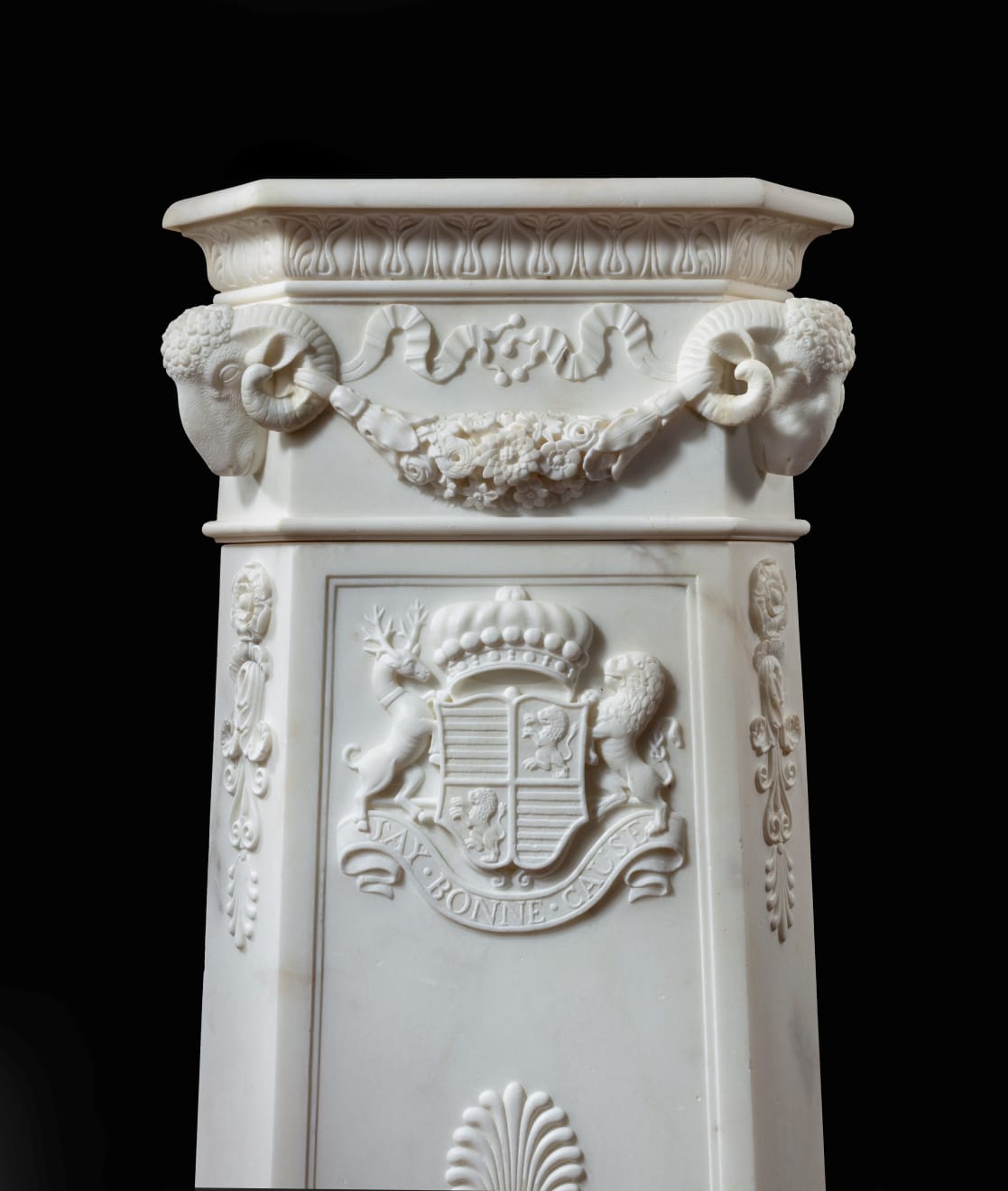Pair of Neo-Classical Carrera Marble Pedestals By Lorenzo Bartolini (1777-1850)
130 x 56 x 48 cm
Further images
Provenance
Commissioned by Thomas Thynne, 5th Viscount Weymouth (1765-1837), son of the Marquis of Bath of Longleat, in Florence.
Offered for sale, unsuccessfully, as part of Viscount Weymouth’s collection of ‘Costly Objects of Taste and Vertu’ on 18th April 1828.
Remained in the Collection of Viscount Weymouth at Shanks House, near Wincanton, Somerset.
Purchased at the Wheatley sale of ‘The Valuable Library of the Late Right Hon. Lord Viscount Weymouth’ held on Saturday 24th June 1837 at Shanks House, Lot 1086, by Mr. Brown (almost certainly Joseph Brown or Browne, owner of a “marble and scagliola works” in University Street, off of Tottenham Court Road in Bloomsbury, London)
Acquired by Mr & Mrs Hayes Burns (sister of J.P. Morgan) between c.1894-1914 for North Mymms Park, Hertfordshire.
(Further notes on provenance available).
Of triangular tapering form, incorporating the arms of the Thynne family of Longleat, near Bath, comprising the motto ‘Jay Bonne Cause’, over scrolls, anthemia and a Vitruvian scrolled border; above the armorials are rams’ heads to each corner, linked by ribbon-tied swags of flowers, standing on two-tier stone plinths. The pedestals are raised on lions’ paw feet, on a dove marble plinth.
The pedestals were described as ‘sculptured by Bartolini’ when they were sold in 1837 and the attribution is supported by the carving on the pedestal of one of Bartolini’s masterpieces, ‘The Campbell Sisters Dancing a Waltz’ which was made in Florence in 1822 and is now in the collection of the V&A (V&A Museum number: A.8:1,2-2015). The carving is remarkably similar, including the same floral models, albeit arranged in a slightly different order.
The other decoration adopts the same motifs used by carvers of Ancient Roman cineraries, which were the inspiration for much Georgian ornament. For example, a Roman marble cinerary urn, from the first half of the 1st Century A.D. has carved garlands of flowers and ears of grain suspended from the horns of rams’ heads at the corners (Sotheby’s, 4th December 2018, Lot 41). Bartolini may have been aware of the 1821 work Architectural Ornaments, or, A Collection of Capitals, Friezes, Roses, Entablatures, Mouldings, &c. Drawn on Stone. From the Antique by the Italian painter and ornamentalist Agostino Aglio, which showed examples of classical ornament. Some of Bartolini’s own drawings held at the Uffizi also show motifs employed in the pedestals. (http://www.uffizi.firenze.it/schedamuseale/Upload/s-28255-21344.jpg)
Lorenzo Bartolini (Prato, 7 January 1777 – Florence, 20 January 1850) studied at the Academy of Fine Arts in Florence. In 1797, he moved to Paris where he studied painting under Frédéric Desmarais and sculpture under François-Frédéric Lemot. In 1803, he received second prize at the Academy with a bas-relief ‘Cleobis and Biton’. Bartolini enjoyed a formidable reputation as a modeller in both alabaster and marble. He was employed on regular occasions by Napoleon and the rest of the Bonaparte family, producing a bust of the emperor amongst other commissions. In 1833, Bartolini was elected to the National Academy of Design as an Honorary member. He then moved to Florence, where he resided until his death. Bartolini’s work is held in many major museum collections including the Metropolitan Museum of Art and the Victoria and Albert Museum.
Thomas Thynne, 5th Viscount Weymouth, was born in Bath in 1796. As the eldest son of the Marquess of Bath and his wife, Isabella, he would have expected to inherit Longleat and the rest of the family estates. At the age of 24, however, Thomas eloped with Harriet Robins, the daughter of the local toll road keeper, and was never to become the 3rd Marquess of Bath. They travelled to Paris in 1820 and travelled extensively in Italy; in total they were away for eight years. During his extended Grand Tour, Thynne acquired a substantial collection of Old Master paintings, sculpture and works of art including works by Rembrandt, Caracci, Canaletto and Reni.
In Europe Thynne met the celebrated Florentine sculptor Lorenzo Bartolini; a favourite of Napoleon and his family. Thynne purchased Bathing Venus and busts of Emperor Napoleon and Lord Byron, as well as commissioning this pair of pedestals incorporating his coat of arms. The coat of arms on the pedestal is not strictly that which should have been used by the 5th Viscount, due to his ‘unsuitable’ marriage.
On his return to England in 1828 Thynne rented Shanks House in Cucklington, (now Somerset) and decided to offer some of the items he had acquired in Europe for sale, through the auction room of George Robins in Covent Garden. Robins described the collection as Costly objects of taste and vertu, collected with infinite care and judgement, and aided by proverbial liberality, during his residence at Rome and Florence. The pair of pedestals failed to reach their high reserve and remained in Thynne’s collection at Shanks House until his premature death in 1837.
We would like to thank Christopher Coles for his assistance with cataloguing these pedestals














